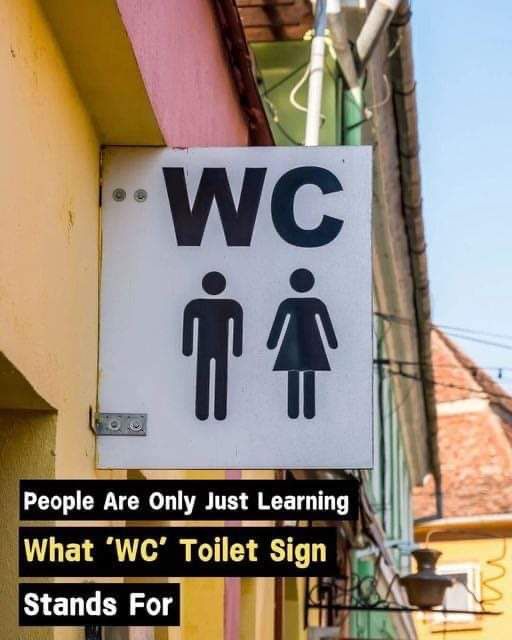If you’ve ever traveled internationally or visited an older building, you’ve probably come across a bathroom labeled with the letters “WC.” For many Americans, it’s a bit of a mystery. We’re used to terms like “restroom,” “bathroom,” or even “ladies’ room” and “men’s room,” but “WC”? That one tends to leave people scratching their heads. Recently, a TikTok video brought this puzzling term back into the spotlight by revealing what “WC” actually stands for: “water closet.” The revelation shocked thousands of viewers, many of whom had seen the term for years without ever knowing its origin. While the abbreviation might seem outdated, it’s still very much in use today, especially in certain parts of the world. And its history is actually a fascinating window into how language—and technology—has evolved over time.

The term “water closet” dates back to the 1870s in Victorian England, a time when indoor plumbing was just beginning to gain traction. Back then, a flushing toilet was a modern marvel, and it was typically installed in a tiny room tucked away in the home—hence the term “closet.” This room, equipped with running water for flushing, became known as a “water closet.” Over time, the phrase was abbreviated to “WC,” and the signage spread as the technology did. What began as a functional descriptor slowly became the go-to label for public toilets across much of Europe and other parts of the world.
What’s interesting is that the phrase “water closet” has almost completely disappeared from everyday conversation, especially in the U.S., where we prefer “restroom” in public settings and “bathroom” in homes—even if there’s no bath in sight. But the abbreviation “WC” has managed to survive, mostly because of its widespread use in signage. In countries like Germany, France, and Italy, the letters “WC” are found on countless doors in airports, hotels, train stations, and restaurants. While most Europeans instantly understand what it means, many travelers—especially from outside of Europe—don’t realize the history behind the abbreviation. That’s why the recent TikTok video struck such a chord. People were both amused and amazed to learn that “WC” was shorthand for something so literal and rooted in 19th-century plumbing.
What makes this story even more fascinating is how language tends to preserve certain words or phrases long after their original meanings have faded from popular use. Today, very few people would call a toilet a “water closet,” yet we still use the abbreviation as if it were common knowledge. It’s a great example of how some terms endure, not because we use them in everyday speech, but because they’ve become embedded in our visual culture—on signs, maps, blueprints, and hotel directories. In fact, some architects and designers still prefer to use “WC” on floor plans and bathroom signage because it’s understood across multiple languages and cultures.
@hullsome Basically every country uses WC to mark a bathroom. I didn’t know what WC meant for the LONGEST TIME. Talk about a conundrum, make sure you have some spare change too! #Bathroom #WC #America #American #European #Europe #Restroom #WaterCloset ♬ Hell To Da Naw Naw Naw – Bishop Bullwinkle
You’ll also find the “WC” label in historic buildings, especially those that want to maintain a traditional or European aesthetic. Even some upscale hotels and resorts use it to create a certain old-world charm. While the term might seem old-fashioned, it’s still effective—and it works as a universal symbol for a very basic human need. Whether you’re fluent in English, French, German, or any other language, you’ll likely understand what “WC” means when you see it.
This tiny piece of linguistic history reminds us just how much language changes with time. New words appear, old ones fade, but some stick around in ways we never expect. “WC” is more than just a quirky abbreviation—it’s a nod to the past, to the early days of indoor plumbing, and to the way we communicate across cultures without saying a word. The next time you see those two letters on a restroom door, you’ll know it’s more than just a sign. It’s a piece of history that has quietly followed us into the modern world, one flush at a time.





